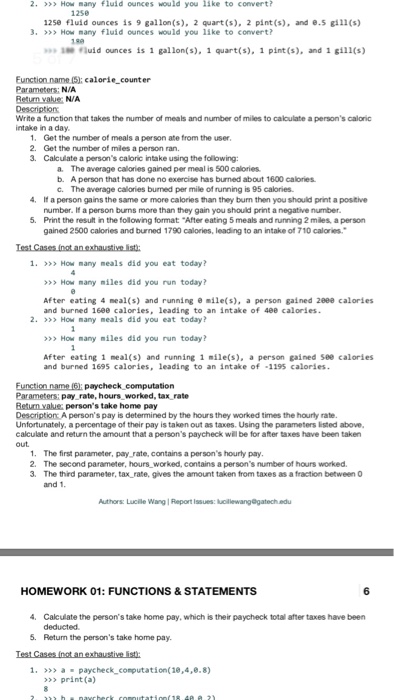> > > How many fluid ounces would you like to convert? 1250 1250 fluid ounces is 9 gallon (s), 2 quart (s), 2 pint (s), and theta.5 gill (s) 3. > > > How many fluid ounces would you like to convert? 180 180 fluid ounces is 1 gallon (s), 1 quart (s), 1 pint (s), and 1 gill(s) Function name (5): caloric_counter Parameters: N/A Return value: N/A Description Write a function that lakes the number of meals and number of males to calculate a person's caloric intake in a day. 1. Get the number of meals a person ate from the user. 2. Got the number of miles a person ran. 3. Calculate a person's caloric intake using the following: a. The average calories gamed per meal is 500 calories. b. A person that has done no exercise has burned about 1600 calories C. The average calories burned per mile of running is 95 calories 4. If a person gains the same or more calories ran they bum then you should print a positive number. If a person bums more than they gain you should print a negative number. 5. Print the result in the following format: "After eating 5 meals and running 2 miles a person gained 2500 calories and burned 1790 calories, leading to an intake of 710 calories * Test Cases (not an exhaustive list): 1. > > > How many meals did you eat today? 4 > > > How many miles did you run today? 0 After eating 4 meal (s) and running theta = mile (s), a person gained 2000 calories and burned 1600 calories, leading to an intake of 400 calories. 2. > > > How many meals did you eat today? 1 > > > How marry miles did you run today? 1 After eating 1 meal (s) and running 1 mile (s), a person gained 500 calories and burned 1695 calories, leading to an intake of -1195 calories. Function name (6): paycheck_computation Parameters: pay_rate, hours_worked, tax_rate Return value: person's take home pay Description: A person's pay is determined by the hours they wotted times the hourly rate. Unfortunately, a percentage of their pay is taken out as taxes. Using the parameters listed above, calculate and return the amount that a person's paycheck will be for after taxes have been taken out 1. The first parameter, pay rate, contains a person's hourly pay. 2. The second parameter, hours_worked, contains a person s number of hours worked. 3. The third parameter, tax_rate, gives the amount taken from taxes as a fraction between 0 and 1. 4. Calculate the person's take home pay. which is their paycheck total after taxes have been deducted. 5. Return the person's take home pay. Test Cases (not an exhaustive list): 1. > > > a = paycheck_computation (10, 4, 0, 8) > > > print (a) 8







